Indoor environmental management (dust mites, mold)
Last updated on: 8 April 2019 | Released on: 21 April 2017
Indoor environmental management (dust mites, mold)
In some allergic disorders, such as bronchial asthma and atopic dermatitis, allergic symptoms may be triggered by the inhalation of dust mite droppings or mold (commonly known as house dust). Although dust mites and mold can be found anywhere, it is important to manage your environment so they do not proliferate too much.
Here, we will explain “1. Key points for dust mite control” and “2. Key points for mold control.”
1. Key points for dust mite control
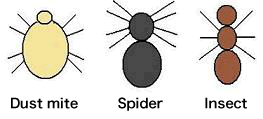
Figure 1: Morphological differences between dust mites, spiders, and insects
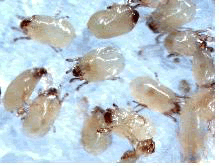
Photograph 1: Epidermoptidae (stereoscopic microscope)
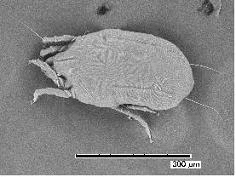
Photograph 2: Epidermoptidae (scanning electron microscope)
*Photographs 1 and 2 (Source: Department of Pharmaceutical and Environmental Science, Tokyo Metropolitan Institute of Public Health)
(2) Places where Epidermoptidae like to live
Dust mites require 3 conditions to live.
- Food: Dead skin shed by humans, mold, food scraps
- Hiding place: Small crevices in tatami mats, carpets, bedding, etc.
- Warmth and humidity: Optimal temperature 25-30ºC, relative humidity 60-80%
(3) To reduce dust mite allergens
To reduce dust mites which cause allergies, it is important to eliminate as much of the above 3 conditions as possible.
Here are some specific actions you can take.
- Cleaning the floor: Carefully and slowly (about 20 seconds per square meter*) vacuum carpets, tatami and other flooring, and sofas etc. to remove allergens such as dust mites, their droppings, and anything that they can feed on.
*Japanese Society of Allergology’s “Asthma Prevention and Management Guideline 2015” - Bedding: Air out futons outdoors on sunny days. After airing thoroughly, vacuum their surface. Use machine washable futons and blankets. Change sheets, futon covers, and pillow cases frequently.
- Materials which are less hospitable to dust mites: Wood or vinyl flooring instead of carpet, or synthetic leather instead of upholstery for sofas and chairs. Tightly woven, allergy-relief sheets and futon covers prevent dust mites from penetrating into bedding.
- Reduce humidity: Keep indoor humidity no higher than 60% by airing, ventilation, and dehumidifying. Use a dehumidifier during the rainy season, and avoid excessive use of humidifier in winter. Keeping humidity down also helps to prevent mold.
- Reduce clutter: Epidermoptidae thrive in places which are difficult to clean. Keep furniture and closets organized so that they are easy to dust and clean frequently.
2. Mold control
(1) What is mold?
Molds are made up of reproductive spore cells (“seeds” in a vegetable) and tube-like hyphae which absorb nutrients. Molds can grow wherever there is moisture and a certain level of nutrition. A visible growth of mold has about 100 billion spores within an area of about 3 square centimeters. Although the hyphae are limited to their physical extension, the spores can become airborne. This enables mold to spread rapidly.
Mold spores and hyphae can themselves be allergens. Spores are about 1/200 to 1/20 of 1 millimeter in size, and are known to become established readily in the nasal mucous membrane or bronchial tubes.
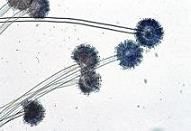
Photograph 3: Green mold
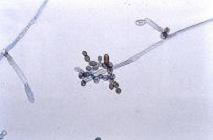
Photograph 4: Black mold
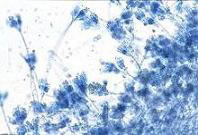
Photograph 5: Blue mold
*Photographs 3 to 5 provided by Microbiology Dept., Tokyo Metropolitan Institute of Public Health
(2) Where mold grows
Mold growth requires moisture. Mold will thrive indoors in the kitchen and bathroom sink areas, which are often wet, and in closets, where humidity levels can get high due to poor ventilation. Once established in these places, mold will spread according to the humidity conditions.
(3) Mold prevention
1. Mold prevention in the bathroom and sink area
- Drain the bathtub after use, and wash thoroughly.
- Remove soap residue, hair, and grime from the bathroom walls, ceiling, and washing area.
These provide food for molds to thrive. If possible, wash away with a hot shower followed by a cold shower to prevent mold from growing. - Using a towel, wipe away any water droplets from bathroom walls, washing areas, around sinks, and around the washing machine. Remaining water droplets allow mold spores to become established. Removing moisture is effective.
2. Preventing mold in the entranceway and shoe closet
- Before putting shoes away, let them dry thoroughly out of direct sunlight.
- Keep storage areas well ventilated.
- Before putting shoes away for the season, remove any dirt and grime and protect the surface with cream to prevent mold growth.
3. Mold control in the living room
- Clean air conditioning filters frequently. An air conditioner which have been unused for some time may have significant mold growth on the filters. Turning such an air conditioner on will allow the mold spores to be released into the room. It is important to dust and clean filters frequently.
- A rough guide to filter cleaning is 3 or 4 times a year, or at least when switching from cooling to heating season and vice versa.
4. Mold control for carpets
- Insufficiently cleaned carpets can allow mold to thrive alongside the dust accumulation. When vacuuming carpets, pull the nozzle against the lay of the pile so that the carpet fibers stand up.
- If possible, wash carpets and dry thoroughly.
- If possible, avoid laying carpets on tatami mats.
5. Mold control for furniture and bureau drawers
- Avoid placing furniture flush against walls, as this reduces air flow and creates a high humidity environment for mold to thrive. Leave at least 5 cm between furniture and wall to allow for good air flow.
6. Mold control in closets
- Mold may even grow in plastic storage boxes kept inside closets. Placing a dessicant packet (moisture absorber) inside the storage box will help prevent mold.

